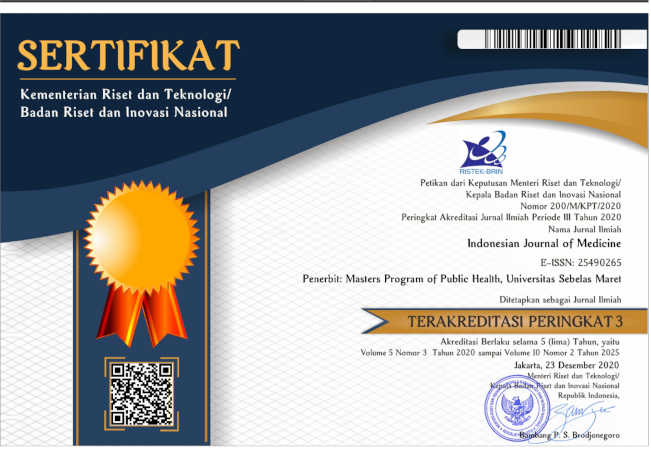Assessment of Muscle Strength in Para Sport Athletes: A Systematic Review
DOI:
https://doi.org/10.26911/theijmed.2025.10.1.835Abstract
Background: Accurate and reliable muscle strength assessment is essential for monitoring injury risk, monitoring the effectiveness of rehabilitation or strength training programs, and for sport classification purposes. This study aims to look at measurement tools to assess muscle strength in para-athletes, look at the characteristics of muscle strength assessment methods, and determine the validity and reliability of several muscle strength measurement tools.
Subjects and Method: This systematic review used methods described in the Cochrane Handbook for Systematic Reviews of Interventions and reported according to the Preferred Reporting Items for Systematic Reviews and Meta-Analyses (PRISMA) guidelines. Data searches in several databases (PubMed, Scopus, and Google Scholar) were conducted using the boolean search method. The keywords used in the literature search were “muscle strength” OR “muscle power” AND “assessment” OR “outcomes” AND “isometric contraction” OR “isotonic contraction” AND “para-sports” OR “para-athletics” AND “paralympic”.
Results: Isometric strength testing was shown to be valid and reliable (ICC 0.85) but limited to static measurements; isokinetic testing was shown to be valid and reliable (ICC 0.81-0.95) but required expertise, specialized equipment, and was time-consuming. MMT, although frequently used, shows variable validity and reliability and is highly subjective.
Conclusion: Muscle strength assessment with isometric and isokinetic tests is effective for para-athlete classification. However, more standardized muscle strength assessment methods are needed to ensure a more objective classification of para-athletes.
Keywords:
muscle strength, para-athletes, isometric test, isokinetic test, muscle manual testing, classificationReferences
Altmann VC, Groen BE, Hart AL, Vanlan-dewijck YC, Keijsers NL (2018). Classifying trunk strength impairment according to the activity limitation caused in wheelchair rugby performance. Scand J Med Sci Sports. 28(2): 649–657. Doi: 10.1111/sms.12921.
Alvares DAR, Rodrigues R, Franke RDA, Silva BGCD, Pinto RS, Vaz MA, Baroni BM (2015). Inter-machine reliability of the bio dex and cybex isokinetic dynamometers for knee flexor/ extensor isometric, concentric, and eccentric tests. Phys Ther Sport. 16(1): 59–65. Doi: 10.1016/j.ptsp.2014.04.004.
Beckman EM, Connick MJ, Tweedy SM (2016). How much does lower body strength impact paralympic running performance?. Eur J Sport Sci. 16(6): 669–676. Doi: 10.1080/17461391.-2015.1132775.
Cobanoglu G, Guzel NA, Seven B, Keklik SS, Savas S, Kafa N (2020). The Comparison of flexibility and isokinetic shoulder strength in a wheelchair and able-bodied basketball players. Turkiye Klinikleri J Sports Sci. 12(3): 349–357. Doi: 10.5336/sportsci.2020-75591.
Connick MJ, Beckman E, Vanlandewijck Y, Malone LA, Blomqvist S, Tweedy SM (2018). Cluster analysis of novel isometric strength measures produces a valid and evidence-based classification structure for wheelchair track racing. Br J Sports Med. 52(17): 1123–1129. Doi: 10.1136/bjsports-20-17-097558.
Douer OF, Koseff D, Tweedy S, Molik B, Vanlandewijck Y (2021). Challenges and opportunities in wheelchair basketball classification – a delphi study. J Sports Sci. 39(1): 7–18. Doi: 10.1080/02640414.2021.1883310
Freitas PS, Santana TS, Manoel LS, Serenza FDS, Riberto M (2021). A comparison of isokinetic rotator cuff performance in wheelchair basketball athletes vs. non-athletes with spinal cord injury. J Spinal Cord Med. 44(4): 557–562. Doi: 10.1080/10790268.2019.1603489.
Garcia-Carrillo E, Yanez-Sepulveda R, Cortes-Roco G, Ramirez-Campillo R, Izquierdo M (2023). Anthropometric characteristics, handgrip strength, and upper limb asymmetries in highly trained chilean shot put para-athletes. Int J Morphol. 41(4): 1123–1127. Doi: 10.4067/S0717-95022023-000401123.
Hogarth L, Nicholson V, Spathis J, Tweedy S, Connick M, Vliet PVD, Payton C, et al. (2019). A battery of strength tests for evidence-based classification in para swimming. J Sports Sci. 37(4): 404–413. Doi: 10.1080/0264041-4.2018.1504606.
Iturricastillo A, Garcia-Tabar I, Reina R, Garcia-Fresneda A, Carmona G, Perez-Tejero J, Yanci J (2022). Influ-ence of upper-limb muscle strength on the repeated change of direction ability in international-level wheelchair basketball players. Res Sports Med. 30(4): 383–399. Doi: 10.1080/15438627.2021.1888110.
Kokaly M, Morales TV, Sein IM, Garcia F, Herrera F, Henriquez M (2023). Muscle strength differences of ham-string-to-quadriceps ratio in para-footballers with cerebral palsy. Eur J of Hum Mov. 51: 46–59. Doi: 10.21134/eurjhm.2023.51.5.
Kollock R, Lunen BLV, Ringleb SI, Onate JA (2015). Measures of functional performance and their association with hip and thigh strength. J Athl Train. 50(1): 14–22. Doi: 10.4085/-1062-6050-49.3.49.
Külünkoǧlu B, Akkubak Y, Ergun N (2018). The profile of upper extremity muscular strength in female wheelchair basketball players: a pilot study. J Sports Med Phys Fitness. 58(5): 606–611. Doi: 10.23736/S0022-4707.17.06862-1.
Liljedahl JB, Arndt A, Nooijen CF, Bjerke-fors A (2023). Isometric, dynamic, and manual muscle strength measures and their association with cycling performance in elite paracyclists. Ame J Phys Med Rehabil. 102(5): 461–467. Doi: 10.1097/PHM.0000000000002014.
Mason BS, Altmann VC, Hutchinson MJ, Goosey-Tolfrey VL (2020). Validity and reliability of isometric tests for the evidence-based assessment of arm strength impairment in wheel-chair rugby classification. J Sci Med Sport. 23(6): 559–563. Doi: 10.1016/j.jsams.2019.12.022.
Mason BS, Altmann VC, Hutchinson MJ, Petrone N, Bettella F, Goosey-Tolfrey VL (2021). Optimising classification of proximal arm strength impairment in wheelchair rugby: a proof of concept study. J Sports Sci. 39(sup1): 132–139. Doi: 10.1080/0264-0414.2021.1883291.
Muchaxo REA, Groot SD, Kouwijzer I, Woude LHV, Nooijen CFJ, Janssen TWJ (2022). Association between upper-limb isometric strength and handcycling performance in elite ath-letes. Sports Biomech. 1–20. Doi: 10.1080/14763141.2022.2071760.
Nowak AM, Molik B, Kosmol A, Szczepaniak M, Marszalek J (2021). Application of the arm-cranking 30-second wingate anaerobic test (the WAnT) to assess power in amputee football players. Acta Bioeng Biomech. 23(3): 13–23. Doi: 10.37190/ABB-01807-2021-02.
Neto FR, Costa RRG, Tanhoffer RA, Leal JC, Bottaro M, Carregaro RL (2020). Muscle strength cutoff points for functional independence and wheel-chair ability in men with spinal cord injury. Arch Phys Med Rehabil. 101(6): 985–993. Doi: 10.1016/j.apmr.2020.01.010.
Yanci J, Granados C, Otero M, Badiola A, Olasagasti J, Bidaurrazaga-Letona I, Iturricastillo A, et al. (2015). Sprint, agility, strength and endurance capa-city in wheelchair basketball players. Biol Sport. 32(1): 71–78. Doi: 10.5604/20831862.1127285.











